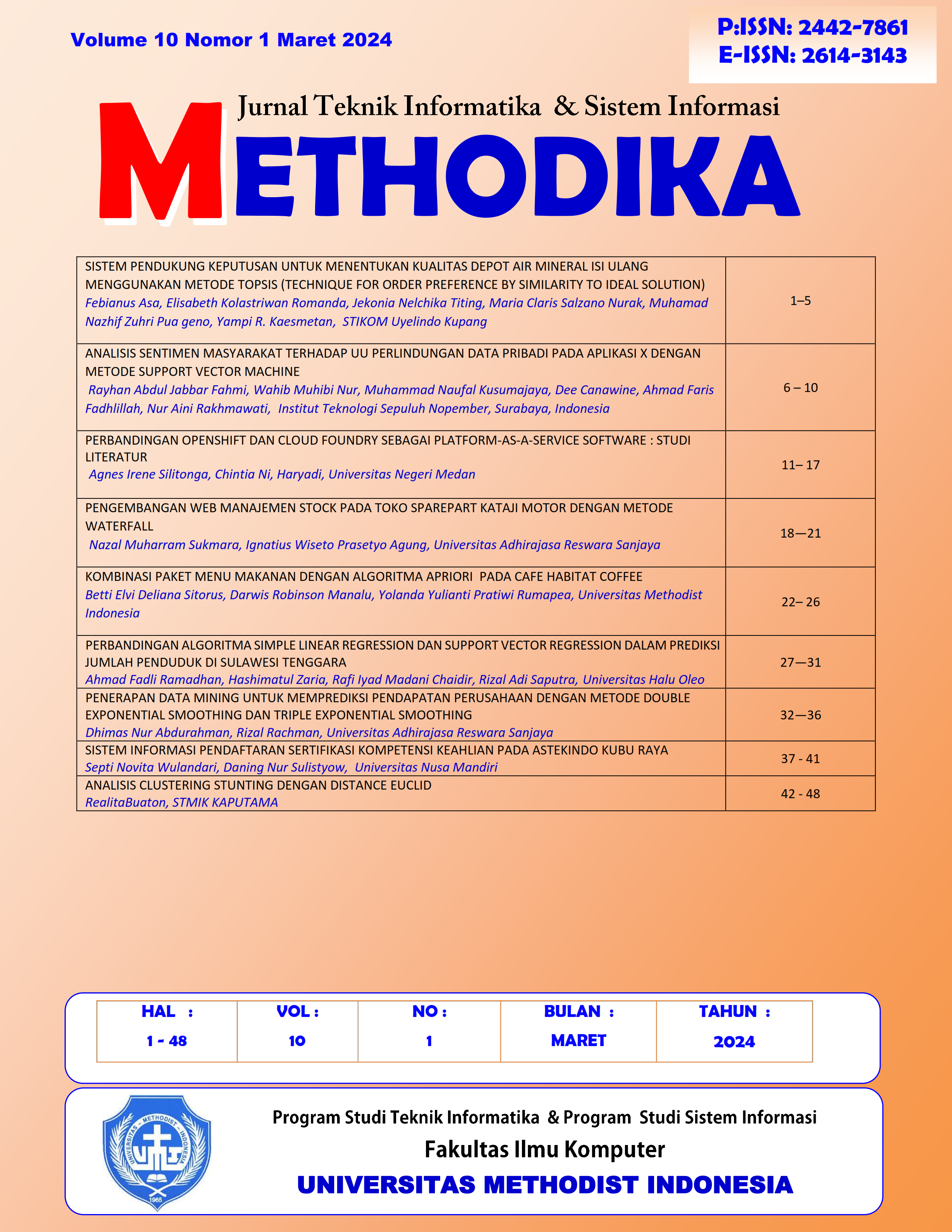ANALISIS CLUSTERING STUNTING DENGAN DISTANCE EUCLID
Keywords:
Cluster stuntingAbstract
Entering the Industrial Revolution Era 4.0, human resources must be supported by healthy and intelligent human resources so that they can increase competitiveness. The world still faces the problem of hunger and malnutrition today. According to a Unicef report, many people suffer from malnutrition in the world. The World Health Organization (WHO) says that malnutrition is a dangerous threat to the health of the world's population. Stunting also has an impact in Indonesia, the prevalence of toddlers experiencing stunting in Indonesia is 24.4% in 2021. The solution created is to classify and cluster stunting so as to produce patterns that can be used as best practice to be transmitted to other affected areas. The algorithm used is Euclid, the Euclid algorithm is able to cluster stunting prevalence data into 3 clusters with a little category of 66%, a medium category of 28%, a lot of category of 6%. The results of the classification and clustering of the best stunting prevalence in cluster two with a small number, can be used as a source of accurate and updated information that can be used by the government in its efforts to optimize stunting handling in each district/city based on artificial intelligence which can provide patterns for handling and optimizing stunting. in each district/city. Malnutrition is estimated to be the main cause of 3.1 million child deaths every year. Therefore, efforts need to be made to minimize stunting by predicting stunting sufferers. The prediction results can be used as an early prevention effort.
References
D. Bayu, “Prevalensi Stunting di Indonesia Capai 24,4% pada 2021.” 2022, [Online]. Available: https://dataindonesia.id/ragam/detail/prevalensi-stunting-di-indonesia-capai-244-pada-2021.
Rokom, “Prevalensi Stunting di Indonesia Turun ke 21,6% dari 24,4%.” 2023, [Online]. Available: https://sehatnegeriku.kemkes.go.id/baca/rilis-media/20230125/3142280/prevalensi-stunting-di-indonesia-turun-ke-216-dari-244/#:~:text=Kementerian Kesehatan mengumumkan hasil Survei,21%2C6%25 di 2022.
K. Rahmadhita, “Permasalahan Stunting dan Pencegahannya Stunting Problems and Prevention,” J. Ilm. Kesehat. Sandi Husada, vol. 11, no. 1, pp. 225–229, 2020, doi: 10.35816/jiskh.v10i2.253.
F. M. Mulyaningrum, M. M. Susanti, and U. A. Nuur, “Faktor – Faktor Yang Mempengaruhi Stunting Pada Balita Di Kabupaten Grobogan,” J. Keperawatan dan Kesehat. Masy. STIKES Cendekia Utama Kudus, pp. 74–84, 2021.
R. I. Sutarto, Diana Mayasari, “Stunting , Faktor Resiko dan Pencegahannya Stunting , Risk Factors and Prevention,” Agromedicine, vol. 5, pp. 540–545, 2018.
K. K. dan Informasi, “Layanan Kesehatan dan Kemajuan Teknologi Digital.” 2019, [Online]. Available: https://www.kominfo.go.id/content/detail/17698/layanan-kesehatan-dan-kemajuan-teknologi-digital/0/sorotan_media.
A. Dwi, L. Id, R. Dwi, W. Id, and N. Amaliah, “Stunting among children under two years in Indonesia : Does maternal education matter ?,” pp. 1–11, 2022, doi: 10.1371/journal.pone.0271509.
U. Fayyad, G. Piatetsky-Shapiro, and P. Smyth, “From Data Mining to Knowledge Discovery in Databases,” AI Mag., vol. 17, no. 3, p. 37, 1996, doi: 10.1609/aimag.v17i3.1230.
H. Ding, G. Trajcevski, P. Scheuermann, X. Wang, and E. Keogh, “Querying and Mining of Time Series Data : Experimental Comparison of Representations and Distance Measures,” 2008.
T. Warren Liao, “Clustering of time series data - A survey,” Pattern Recognit., vol. 38, no. 11, pp. 1857–1874, 2017, doi: 10.1016/j.patcog.2005.01.025.
T. Oates, “Identifying Distinctive Subsequences in Multivariate Time Series by Clustering,” Proc. fifth ACM SIGKDD Int. Conf. Knowl. Discov. data Min. - KDD ’99, pp. 322–326, 1999, doi: 10.1145/312129.312268.
T. Rakthanmanon et al., “Addressing Big Data Time Series: Mining Trillions of Time Series Subsequences Under Dynamic Time Warping,” Trans. Knowl. Discov. from Data (TKDD, vol. 7, no. 3, pp. 3047–3051, 2013, doi: 10.1145/2500489.
R. J. Hilderman and H. J. Hamilton, “Heuristic Measures of Interestingness,” pp. 232–241, 1999.
R. Buaton, M. Zarlis, and H. Mawengkang, “OPTIMIZATION OF FORECASTING TIME SERIES WITH RBT ( RULE BEST TIME SERIES ),” vol. 98, no. 15, pp. 2977–2989, 2020.
Downloads
Published
How to Cite
Issue
Section
License
Copyright (c) 2024 Realita Buaton

This work is licensed under a Creative Commons Attribution 4.0 International License.











